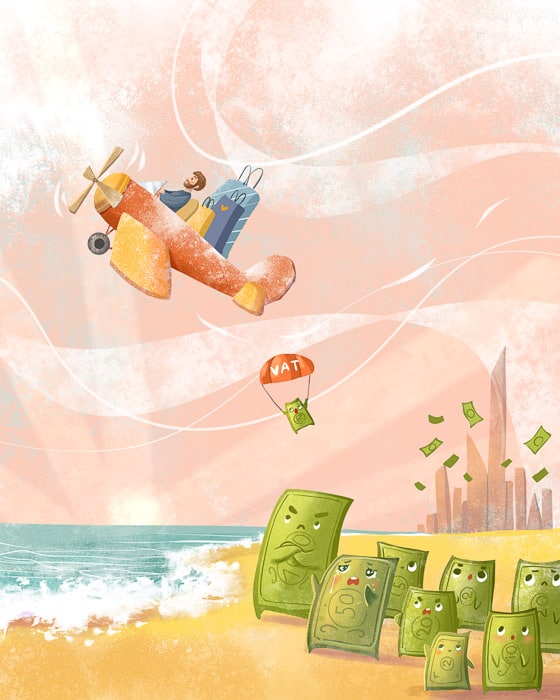Last Updated on November 22, 2022 by underanewsun
Disclosure: Some, but not all, links on this post are affiliate links. Purchases made on affiliated sites result in compensation to our website (at no additional cost to you).
Want to save money on your next trip abroad? Excellent! Let’s talk about value-added taxes, then. What are those? They’re the taxes you pay when buying goods and services in other countries.
When you visit a country that charges a value-added tax (VAT), you may request a refund of the tax you’ve paid on qualifying purchases. Millions never do and, consequently, leave billions of dollars behind.
Why do tourists leave so much money behind? Some can’t be bothered, but most simply don’t know refunds are an option.
We’ll discuss how you can potentially save money on your next overseas trip.
What is a value-added tax?
Definition of VAT: A consumption tax on goods and services imposed by a country’s national government. Over 160 countries employ a value-added tax.1
Does the U.S. have a value-added tax? No, most U.S. states impose a sales tax.
Aren’t they the same thing? Sort of. For you as a consumer, they are: both are taxes you pay when buying stuff. But there are also significant legal and accounting differences between them which we won’t cover here.
Instead, we’ll focus on the most important things to remember:
- You pay value-added tax when making purchases overseas.
- You may request a refund of the taxes you’ve paid on certain items.
VAT Example: You buy €600 (six-hundred Euros) worth of perfume in Paris. France’s value-added tax rate is 20%. In this transaction, the French government receives €100 and the perfume retailer receives €500. Thus, you can request a refund of the €100 you’ve paid in tax (minus any fees).
And that’s just one transaction!
You might be saying, Wait a minute, 20% of €600 is €120, not €100.
Correct, but remember: value-added tax is based on an item’s pre-tax price.
The sales price already includes the tax. Don’t sweat it, we’ll cover this in the next section.

© Under A New Sun
How to calculate Value-Added Tax
Calculating value-added tax
Using the French perfume example again, let’s determine:
- The amount of value-added tax you are paying
- The perfume’s cost before value-added tax is added
- What percentage of the total cost is the value added tax?
How to calculate value-added tax paid:
VAT paid = Item cost ÷ (1 + VAT rate) x VAT rate
€600 ÷ 1.2 x 0.2 = €100
- €600 = total perfume cost
- 1.2 = 1+ VAT rate (20% in this case)
- 0.2 = VAT rate (20%)
- €100 = Amount of value-added tax paid
How to calculate an item’s pre-VAT cost
Item’s pre-tax cost = Item cost ÷ (1 + VAT rate)
€600 ÷ 1.2 = €500
- €600 = total perfume cost
- 1.2 = 1 + VAT rate (20% in this case)
- €500 = cost of item without value-added tax
How to calculate value-added tax as a percentage of total item cost:
Value-added tax as a % of total cost =
VAT paid ÷ total item cost
€100 ÷ 600 = 16.67%
- €100 = amount of value-added tax paid
- €600 = item’s total cost
- 16.67% = value-added tax as a % of total cost
As a thank you for visiting us today, we’d like to offer you two complimentary tools to help you keep track of your refund-eligible purchases. The first is a log sheet to manually track/calculate your purchases and potential refunds. The second is a spreadsheet that will do the calculations for you. Find them at our VAT worksheet page.
How to claim your VAT refund
Claiming refunds
- Store reimburses you
Some stores will refund you immediately, while you’re still in the store.
Your tax-free forms will still need to be validated by customs and returned to the store within a certain time. If not, your credit card will be charged the tax due (plus penalties).
2. Use a refund processing company
Refund processing companies will expedite your refunds for a fee. Their streamlined phone apps even allow you to submit images of your paperwork.
Some stores may even refer you to a nearby refund processing company’s office.
Global Blue and Planet are two leading refund processing companies. Stores partnering with these companies often have a “Tax-Free Shopping” sign/sticker somewhere.
Your refund method options are determined by a country’s banking laws and the services offered by a refund processing company in that country.
Take Planet, for example. In some countries, they give you three choices:
- You’re not charged the value-added tax at all.
- Planet reimburses you within 72 hours.
- Planet reimburses you within 30 days.
Global Blue has locations in many airports and rail stations. Once customs validates your paperwork, you can turn it in to a Global Blue kiosk or, if you’re in a rush, drop it into one of their designated boxes.
3. Do it yourself
Fill out your forms, certify your form with customs and return it to the retailer, either by mailing it from the airport before leaving or from your home country.
This method saves you on commissions, but takes the longest (from a few weeks to six months). It may also increase the possibility of your paperwork being “lost.”
What will I need to claim my VAT refund?
What you’ll need…
- Your tax-free form(s)
- Passport
- Original purchase receipt(s)
- Your purchase(s)
Your tax-free form: The store will provide and fill out this official government form. It must be validated by a customs agent, then sent back to the store or a refund processing company.
Your passport: Stores and customs officials will need it to complete/certify your tax-free forms.
Receipts: Customs will ask for your original receipts. Copies are not accepted.
Merchandise: Customs will inspect your merchandise. If it will be in checked baggage, be sure to visit customs before checking-in.
Why do governments give VAT refunds?
Congratulations, you’re an exporter!
Customs will ask to see your new items. Keyword: new. You should avoid opening sealed items or wearing wearable items.
Why? Well, let’s just say governments don’t grant these tax refunds to be nice or to thank you for stopping by.
VAT refunds exist because you are, legally speaking, acting as an exporter. That’s right. By going home with your new items, you are technically exporting them.
Value-added tax is not charged on exported items as long as they are not consumed before leaving the country/territory you’re visiting.
That’s why you cannot request tax refunds on your hotel stays and meals. Both of these are consumed while you are in that country and, therefore, do not qualify for refunds.
When customs officials inspect your items and stamp your tax-free form(s), they are certifying that you are exporting your new, unused purchases.
Beware of leaving the European Union
Before leaving the EU, you should…
Not all European countries are part of the European Union (EU). Iceland, Norway, the United Kingdom and Switzerland, among others, are not in the EU.
If you’ll be visiting both EU and non-EU countries, you must complete your EU VAT refund requests before leaving your last stop in the EU. The same applies when traveling from a non-EU country to the EU.
Let’s consider two scenarios.
Scenario 1: You’ll visit Spain, France, Italy and Switzerland (in that order).
To request a tax refund for your EU purchases (those made in Spain, France and Italy), you would hold on to all of your refund paperwork until you were ready to leave Italy.
Italian customs would validate your refund paperwork for purchases made in Spain, France and Italy.
You would complete your Swiss refund requests before leaving Switzerland (a non-EU country).
Scenario 2: You’ll visit: Spain, France, Switzerland and Italy (in that order).
This time, you’ll be traveling from an EU country (France) to a non-EU country (Switzerland) and then back to the EU (Italy). You would retain your EU paperwork (for the purchases you made in Spain, France and Italy) until you were ready to leave for home from Italy.
For purchases made in Switzerland, however, you would complete your refund requests before leaving Switzerland. Italy (an EU country) would not process Swiss refund requests because Switzerland is not in the EU.

8 more things to consider
Things to keep in mind
Is it worth it?
Do you really want to moonlight as a forensic accountant during your trip?
OK, maybe it’s not that bad, but it will require time and effort. Crunch the numbers and decide.
Refunds are for short-term visitors only
Foreigners living either permanently or for an extended period in a country are ineligible for refunds.
Minimums and gotchas
Many countries have minimum purchase thresholds to qualify for refunds. Some even require minimums for each store’s receipt. Research your destination’s rules.
Take it easy on the little guys
Planning to make big purchases in big stores in big cities? Go for it! Businesses with heavy tourist traffic are accustomed to helping with refund paperwork.
Small stores, street vendors and stores in remote areas, however, may be unwilling or unprepared to deal with extra government paperwork.
Shipping your merchandise
Some retailers offer shipping assistance.
This option is best suited for lightweight items. Between shipping costs, import duties (in your home country) and the risk of theft/loss, keeping your items with you might be the best option.
Show up early to customs
Finding the right customs office at an airport or train station might take time. Once there, you may have to wait in line. If you’re using a refund processing company, you may have to wait on line yet again.
If you’re crossing land borders, remember that smaller towns may have less staff or be closed after regular business hours.
Tiered tax rates
Many countries have tiered rates. The tax charged on a luxury item, for example, might be higher than the tax charged on, say, a book or a meal. Look into the specifics of your destination.
Consumption taxes go by different names.
You may see initials such as:
- IVA: Italian, Portuguese and Spanish-speaking countries
- TVA: France
- MwST: Germany
- moms: Denmark (and, yes, you read that correctly–moms)
- GST (General Services Tax): Spain, Greece, India, Canada, Singapore, and Malaysia.
As a reminder, always research the specific rules and procedures of your destination(s). Happy and safe travels.
Citations
- https://www.imf.org/en/Publications/fandd/issues/2022/03/b2b-value-added-tax-continues-to-expand
- https://taxsummaries.pwc.com/quick-charts/value-added-tax-vat-rates

